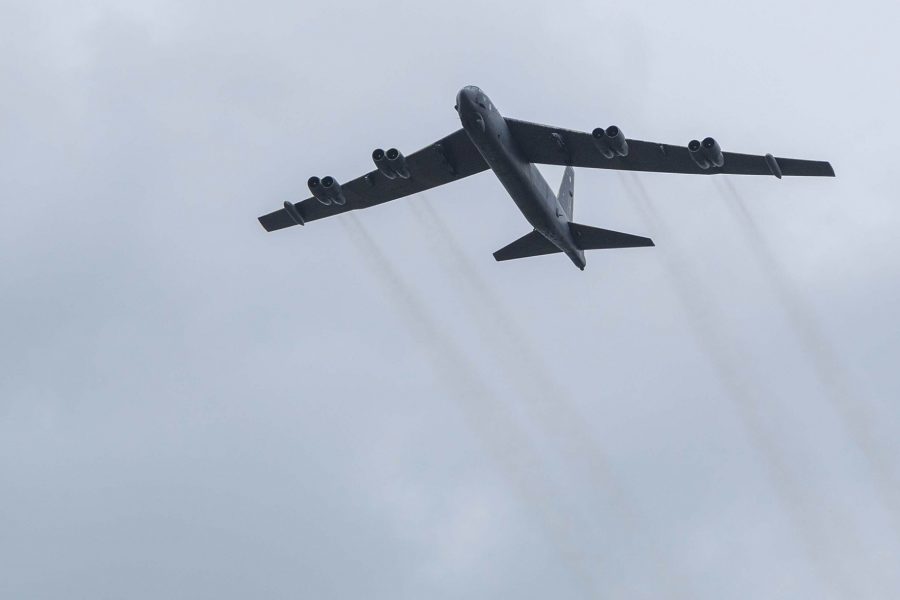The Air Force recently sent an unexpected aircraft over the village of Kismayo, a rural town on the Somali coast that has been a hotbed of extremist activity by groups such as al-Shabab.
A nuclear-capable B-52, forward deployed to U.S. Central Command, flew an unmistakable show of force over the region last month. USAF leaders said the Feb. 15 flight was a direct message, not necessarily to the violent extremist groups armed with AK-47s and pickup trucks, but to global powers working to exert their influence on a continent that is becoming increasingly important to the global power structure.
“There’s a message opportunity here, not just to al-Shabab and [violent extremist organizations] on the ground, but more broadly to Russia and China that: ‘Hey, we’re competing with you down here, we’re engaged here, we have high situational awareness as to what’s going on, and we’re going to use this opportunity to demonstrate that to the collective world,’” US Air Forces in Europe-Air Forces Africa boss Gen. Jeffrey Harrigian told Air Force Magazine.
The “critically important” capability of a strategic bomber, seen as out of place in a region where small arms engagements between local forces is the norm, is a step U.S. Africa Command and USAFE-AFAFRICA hope can have a long-term impact. Harrigian said it shows, “We can be here quick, and we can be here with strength.”
Across the continent, China and Russia are increasing their influence, by direct support to some armed groups and more broadly with investments in things such as infrastructure and ports to try to win influence.
China is the top trading partner on the continent, with 23 different ports under construction. They have a military installation in Djibouti, not far from the main U.S. operating location of Camp Lemonnier, and “they’re looking to expand their influence,” AFRICOM spokesman Col. Christopher Karns said.
Moscow is looking private military corporations (PMCs), such as the Wagner Group, to spread its influence in the region. These companies have taken the model in use in places such as Syria and the contested area of Crimea in Ukraine, and shifted it to places such as Libya.
An example of this could be seen in the November shoot-down of a U.S. MQ-1 over Tripoli. While the Libyan National Army claims the downing, it was a complex air defense system that felled the Reaper, “there’s not a strong belief that in fact they were capable of doing it,” Karns said. It was “either by the LNA operating sophisticated Russian air defences, or by PMCs there themselves,” he said, noting that Russia has PMC involvement in 18 countries on the continent.
“There’s a lot of activity that is occurring, whether it’s Russia and their interference in Libya, or China and the challenges they could present to us in the future if that space is not challenged in a meaningful way,” Karns said.
AFRICOM also is using soft power to try to spread its own influence, including training opportunities such as African Partnership Flight events, exercises such as the recently completed Flintlock, or small interactions such as deploying USAF mobility support advisory squadrons or National Guard State Partnership Program deployments.
“In Africa, we believe our U.S. military training, equipment, and expertise provides an edge in winning partnerships, access, and influence over the likes of Russia and China,” Karns said. “Additionally, the training and engagements we conduct on the continent has the mutual benefit of increasing the U.S.’ readiness as well.”
Defense Secretary Mark Esper has ordered a “zero-based review” of AFRICOM’s force posture, currently about 5,200 personnel, to ensure it is “right-sized” to address the National Defense Strategy, especially to counter Russia and China.
While U.S. forces in Africa are looking ahead at competing with Russia and China, the low-intensity violent extremist fight has been facing challenges. Earlier this week, an MQ-1 from the new USAF operating location in Niger crashed after suffering mechanical problems. Some lawmakers have worried the review would result in a reduction in AFRICOM’s presence and a shift away from fighting groups such as al-Shabab.
The most notable attack on U.S. forces within the country in the past two years took place in January, when al-Shabab was able to breach the perimeter of Camp Simba in Kenya, destroying multiple U.S. aircraft and killing one U.S. Army soldier and two American contractors. AFRICOM boss Gen. Stephen Townsend has said U.S. forces were not ready for the attack, and as a result the command has been increasing security at its locations.
While the investigation is still underway, “there are lessons to be learned from a layered base defense perspective. And the requirement to look at it from an infrastructure and training perspective is something that, unfortunately, these types of activities remind us,” Harrigian said. “… This is a chance to refine the way we do business, and how we train not only individually but collectively.”
Strikes on al-Shabab have continued at a high pace this year, with 63 conducted in 2019 targeting more than 320 al-Shabab targets, and another 20-some strikes conducted so far this year. With more operations being conducted against the group in other parts of the country, such as the Sahel region of Niger and Mali, AFRICOM is trying to balance how it addresses current and future threats.
“We’re starting to see a cooperation between ISIS and al-Qaeda that hasn’t existed anywhere else, but yet they are finding commonality to cooperate and project out a level of strength,” Karns said. “So Africa has that violent extremist organization threat. But at the same time, it has the global power competition dynamic. … You combine the two and that problem set doesn’t exist anywhere else in the world.”
